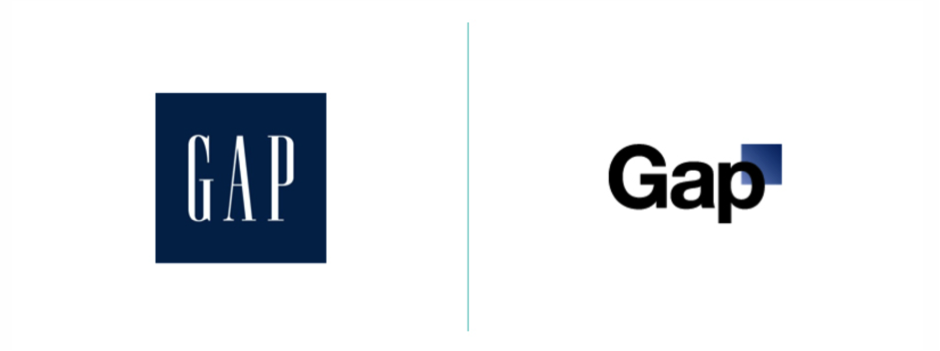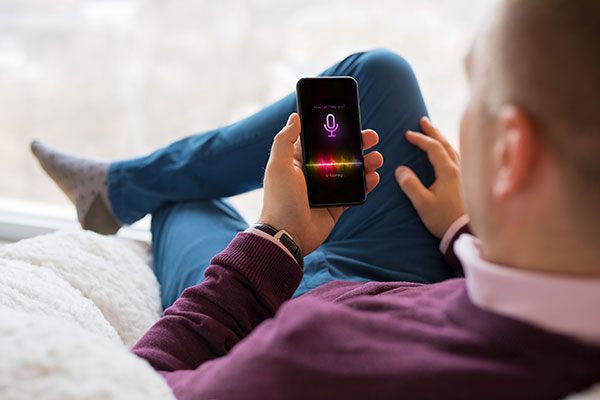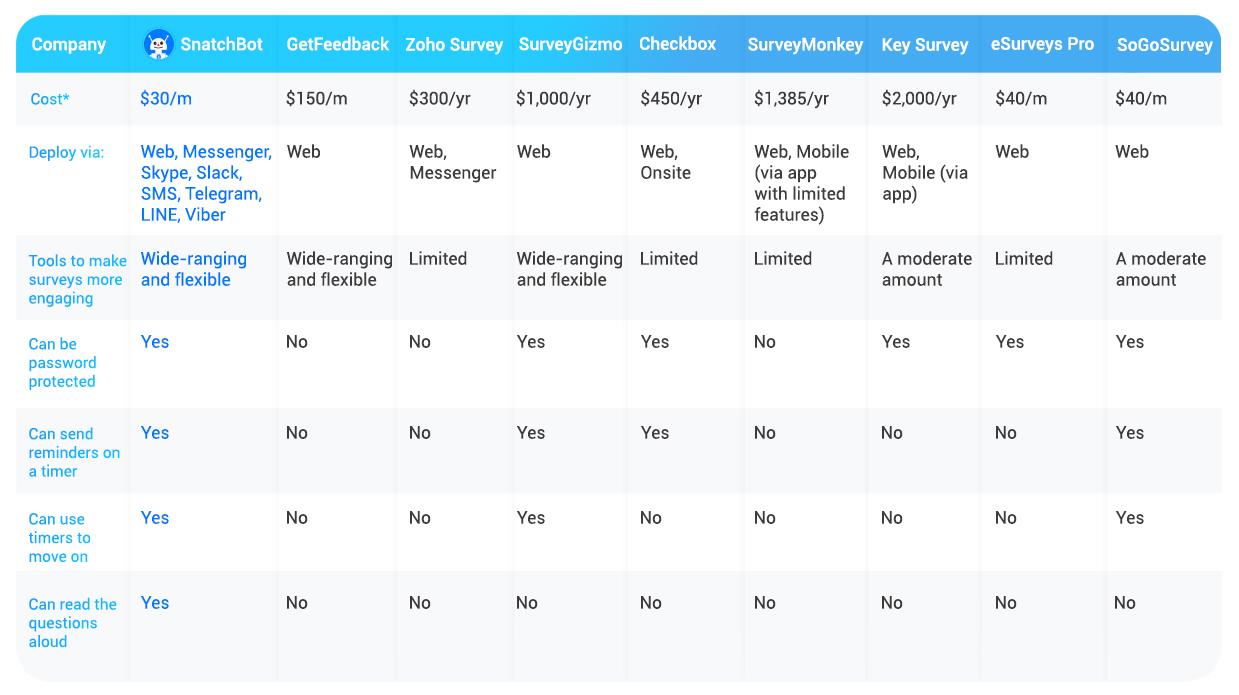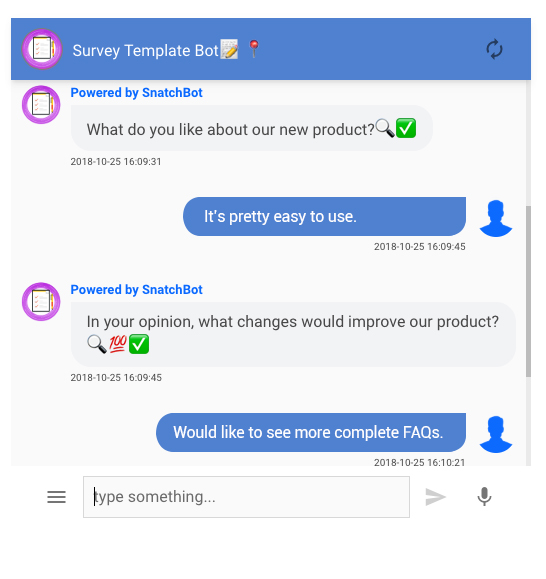Why chatbot surveys are taking over


Surveys are essential for customer feedback – and chatbots overwhelmingly produce the kind of engaging survey options that keep customers engaged, supportive, and even excited to offer feedback.
There is a huge demand for survey software. Not surprising. Every organization that has customers or users, from enormous enterprises and government bodies to SMEs and voluntary sports clubs, benefit from getting feedback from members and clients. With SnatchBot’s arrival on the scene, there is a whole new and exciting way of gathering this data: surveys via chatbot.
For some businesses, understanding and listening to their users can be a matter of success or failure. Consider entrepreneur Hiten Shah’s one costly mistake. “My co-founder and I spent $1 million on a web hosting company that never launched,” he explained. “We were perfectionist so we built the best thing we could without even understanding what our customers cared about.”
 A far more costly failure to understand its customers (some estimates put it at $100 million) was GAP’s 2010 attempt to shift its appeal to a younger, trendy market through a rebranding. The new logo lasted only two days after a tsunami of complaints.
A far more costly failure to understand its customers (some estimates put it at $100 million) was GAP’s 2010 attempt to shift its appeal to a younger, trendy market through a rebranding. The new logo lasted only two days after a tsunami of complaints.
Respondent fatigue is real – but it's easier than ever to overcome that natural response, with a little help from your friends, and your technology.
User data can be incredibly valuable, and surveys are the way organizations attempt to get inside the heads of their users. Yet there is a lot of weariness among the planet’s population about filling in surveys, especially the kind that really dig deep to provide the kind of high-quality information that can successfully guide a strategic decision.
 Of all the types of communication that users are open to receiving (help advice, service updates, appointment reminders, newsletters, invitations, and personal messages), survey requests come in last.
Of all the types of communication that users are open to receiving (help advice, service updates, appointment reminders, newsletters, invitations, and personal messages), survey requests come in last.
We are suffering survey fatigue. Almost certainly as you are reading this, you can think of invitations to complete a survey that you’ve received and – very likely – turned down.
Here are of the tried-and-true ways to overcome that survey fatigue and get your customers on your side.
Lean on the loyal customers who want to help. There really are users who want the opportunity to give feedback. These are likely the loyal customers who appreciate your products or services. And people who feel a certain amount of ownership of an organization – like they are part of the story – are far more likely to respond to a survey. For this kind of supportive audience, it’s crucial that the survey be meaningful and that users understand why the survey will help your business. Then they’re willing to give you their time.
But there is a "don’t" associated with this insight: Don’t appeal to your loyal user base for responses to a survey that asks them to merely tick boxes. These kinds of surveys make it seem as if you’re just going through the motions of appearing to listen to users. Make sure the point of the survey is relevant to a strategic business choice, and be up front with potential respondents about this purpose. They will want to help, and the qualitative responses, where respondents can freely express their opinions rather than just ticking a box, are likely to be especially valuable.
That’s what we discovered in our own survey. When we reached a critical milestone in our roadmap with the launch of text-to-speech in our bots, we drew a breath. Although we had our own ideas about what new features to prioritize, we also knew that this was the right moment to get feedback from the tens of thousands of people building bots on our platform. All metrics we asked about were useful, but the suggestions about our next goals were golden.
Provide your survey where your users are – in social media. Between Q2 and Q3 2017, 121 million new people joined social media, and as of April 2018, the average daily time spent on social media by the world’s population was 116 minutes a day. They're spending a lot of time on Messenger, Telegram, and Whatsapp, exchanging nearly 90 billion messages a day. So if you want to maximize your responses to your survey, you have to meet people where they are: on their mobile devices, and on social media. Don’t send them off to a website that looks tiny, nor expect them to interrupt their social media activity to download your app. For maximum response, put your survey out on their favorite channels.
 Here, SnatchBot is way ahead of the more traditional survey software companies. We recently added LINE, Viber, and Telegram to the channels on which you can deploy our bots and WeChat will be added soon. That’s a reach to over 3.9 billion registered channel users. Our platform is truly omni-channel in the sense that you don’t have to write your survey for each channel and/or need an expensive dedicated software solution to access them. Just create the one chatbot with the survey, and a few clicks launches it on Slack, Skype, Messenger, and more. Not only that, but you can start the survey (like all conversations with our chatbots) on one channel and seamlessly swap to another mid-task. It really is the right tool for the mobile generation.
Here, SnatchBot is way ahead of the more traditional survey software companies. We recently added LINE, Viber, and Telegram to the channels on which you can deploy our bots and WeChat will be added soon. That’s a reach to over 3.9 billion registered channel users. Our platform is truly omni-channel in the sense that you don’t have to write your survey for each channel and/or need an expensive dedicated software solution to access them. Just create the one chatbot with the survey, and a few clicks launches it on Slack, Skype, Messenger, and more. Not only that, but you can start the survey (like all conversations with our chatbots) on one channel and seamlessly swap to another mid-task. It really is the right tool for the mobile generation.
Ramp up user enthusiasm. To get users to happily take your survey, you need to make them enjoyable. "Enjoyable?" you say skeptically? Yes. Surveys don’t need to sound like they're being conducted by a scientist in a white coat, scribbling notes on a clipboard while the user feels like they’re strapped to a chair. A survey can have personality. For a start, the text of the survey can be friendly and chatty, rather than sombre and analytical. Something like, “We’d love to get your opinion about our new flavour," with a range of choices that go from "absolutely yummy" to "uggh, disgusting" rather than, "please score the flavour of our new product out of five, where 1 is poor and 5 is excellent."
There’s no reason, unless your survey platform doesn’t allow it, why you can’t put plenty of emojis in the text as well as GIFs, video clips, images, etc. Make the survey a lively, entertaining experience and users will get into the spirit of it and complete it. If you want to see some examples, the SnatchBot store, which is full of free chatbot templates, has several surveys.
What's the difference between expensive, web-based survey technology and chatbot technology that's easy to implement, easy to use, and has new features arriving at a regular clip? Plenty.
Let's take a look at why it's absolutely clear that chatbots are going to overtake websites as the best survey software.

* Cost: most survey software companies, including SnatchBot, offer free versions; this is the cost of the white label option or removal of promotional branding option.
Chatbots find users where they live online. For a start, most current survey software companies are focused on web-based surveys. That’s a problem when so much online activity is taking place within channels like Messenger. Those trying to reach out to mobile users will also have a problem if they want the user to download an app. No one wants to fill their device with apps they rarely use, nor do people want to be kept waiting on an installation.
Remember, we are battling survey fatigue here. You want the option of participating in your survey to be absolutely frictionless. The experience has to be one of instant engagement, with fun and lively questions, and delivering a genuine sense that they're being of assistance.
Chatbots keep them surprised and delighted. Let’s say that a respondent has begun your survey. Will they break off? Or continue to the end? Will your users feel sufficiently interested in the survey that they are willing to type the kind of qualitative responses that are so vital to the strategic decision you have to make?
 Being able to insert gifs, video clips, music, emoji’s and, above all, feedback, boosts completion rates, as demonstrated by Dr. Diana Derval's case study, where she obtained ten million responses to her colour test. Ten million. What company wouldn’t benefit from that kind of big data response.
Being able to insert gifs, video clips, music, emoji’s and, above all, feedback, boosts completion rates, as demonstrated by Dr. Diana Derval's case study, where she obtained ten million responses to her colour test. Ten million. What company wouldn’t benefit from that kind of big data response.
The survey was hosted on Messenger to meet people where they are spending time, but above all, gave participants interesting feedback at the time of completion: a brief assessment of their type of colour perception. This led to users sharing the survey with their friends. The survey went viral, with three million people taking it in the first three days. Oh, and the survey was managed by a chatbot built on the SnatchBot platform.
Chatbots let your users talk to you. Quite apart from the essential accessibility issue, the survey maker must stay current with technology, and make their surveys fun and engaging by offering conversational options. Conversational software is definitely taking off, and in the near future, more and more interactions between people and technology are going to take the form of a conversation rather than the human tapping out instructions and responses on a keyboard.
People much prefer this experience. Beyond the multitasking capability – when our hands are free we can take a survey while also getting on with other tasks – there's a deeper reason folks are adopting conversational technology: a fundamental trait of our species is that we talk to each other. We are all experts. Young and old, tech savvy or phobic, we can talk. If a survey speaks to us, it is effortless to answer.
In the not-too-distant future, surveys will be carried out by software in much the same fashion as the people with clipboards method, but with immensely greater reach. For now, chatbots are way ahead in terms of engagement with AI, NLP and conversational interactions. The tide is moving away from point and click surveys carried out on websites and it is flowing towards conversational, smart, fun exchanges that are entirely hands free, and SnatchBot is the only chatbot platform offering free text-to-speech.
Chatbots let your surveys talk back. Automatic Speech Recognition is advancing rapidly (and is in the SnatchBot pipeline). What better way to deal with survey fatigue than to keep it conversational? Again, it’s one thing to ask people to interrupt the work they are doing on their computers to take your survey, but quite a different ask if they are walking to the shops. Even those who are well disposed towards you will be reluctant in the first scenario but perfectly willing in the second.
Moreover, with powerful natural language processing (NLP) capabilities already in place on the SnatchBot platform, we can offer a whole new dimension to surveys. They no longer have to be linear, but can be designed in a modular fashion, where users can jump to relevant questions thanks to the NLP understanding their responses and tailoring the survey accordingly.
 Having AI and NLP working for your surveys also allows you to match question and respondent with precision, which means much better results in the analysis. And as well as being able to match all the traditional web-based survey software in terms of producing statistics, the conversational survey contains many other metrics that might be of value, such as incorporating user attributes, including gender and location, adding a whole new dimension for analysis.
Having AI and NLP working for your surveys also allows you to match question and respondent with precision, which means much better results in the analysis. And as well as being able to match all the traditional web-based survey software in terms of producing statistics, the conversational survey contains many other metrics that might be of value, such as incorporating user attributes, including gender and location, adding a whole new dimension for analysis.
Our own analytics pages can deploy all the necessary tools for a thorough understanding of the results. It’s easy to filter the results instantly on the SnatchBot dashboard. Moreover, we are partnered with Chatbase, Google’s chatbot analytics company, which is helping in determining where the user slowed down or broke off their participation in the survey.
Chatbots are affordable. Because Survey Monkey, Survey Gizmo, and Key Survey offer web or app surveys, adding functionalities isn’t easy, and this is reflected in their costs. These companies require $1,000 a year or more to provide you with a white label survey.
Or to make the same point more positively, rewriting a chatbot, adding features, adding engagement tools, sending broadcasts and reminders, and (in the case of SnatchBot) adding a voice to the questions, is all extremely simple. Editing a chatbot is nothing like editing an app, and this is reflected in an astonishing difference in cost.
What can you get, for so much less? Thanks to the evolution of technology, the answer shouldn't surprise you.
We have arrived at the classic situation that occurs regularly in the evolution of technology, where the superior product and solution is cheaper for the user. So cheap, in fact, that it cannot be matched by earlier technologies. While bad news for the old guard, this is, of course, a fabulous development for those wanting to conduct brilliant surveys with high response rates.
With SnatchBot’s free service, you can carry out a survey to respondents on channels that expensive survey solutions cannot reach, and at no cost. The white label that comes with SnatchBot’s Pro-plan starts at only $30 a month (for 10,000 messages exchanged per month).